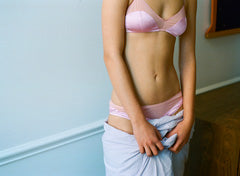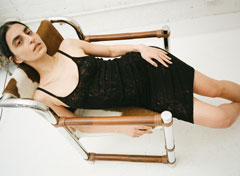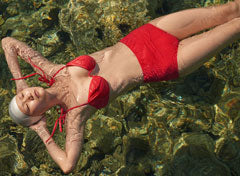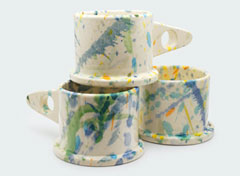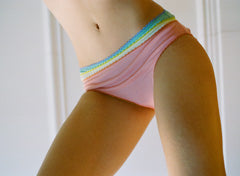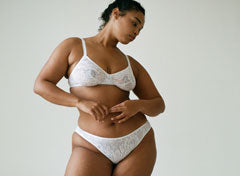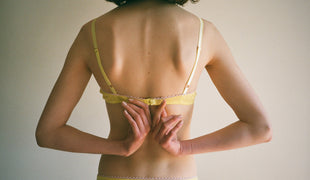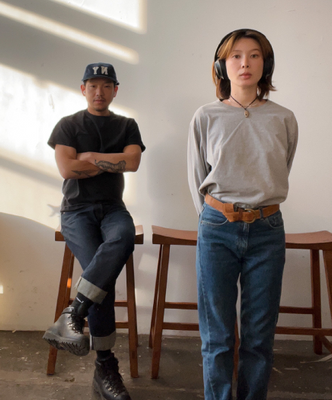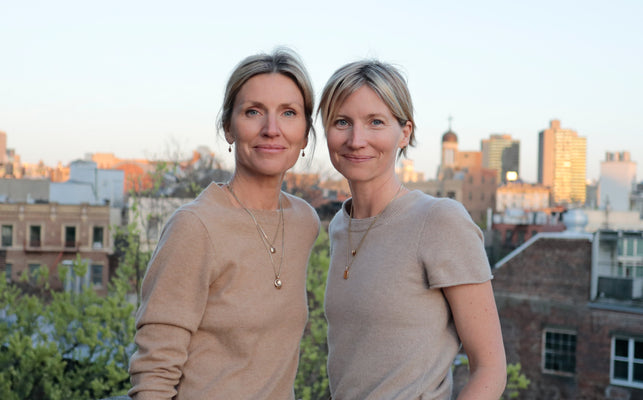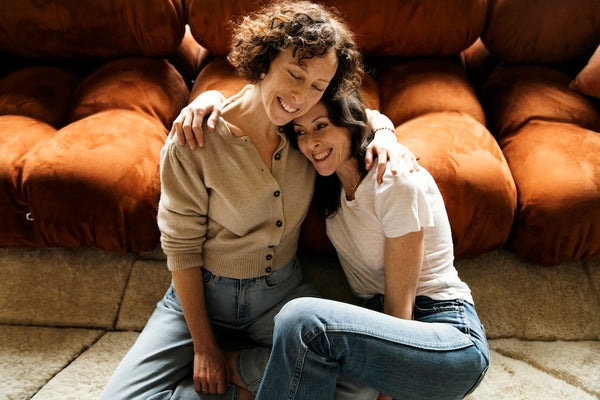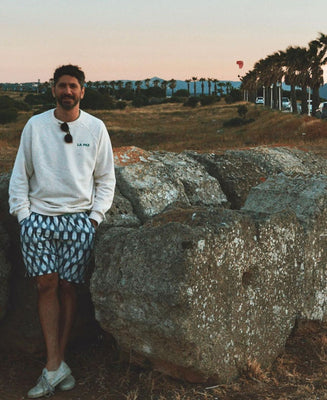JOURNAL

Last summer we started investigating the use of natural dyes. Not only did they peak our interest for their planet-animal-people friendly qualities but the colors obtained from nature are truly unlike anything you can achieve with synthetic dyes. According to @botanicalcolors, natural dyes have more depth than synthetics because most dye plants have multiple dye sources aka chromophores in them. So even if the main color looks red, there are other colors subtly shaping that — and our eyes can pick that up even if our brain doesn't quite process why.
Our curiosity in supernatural friendly colors lead us to Isa Rodrigues, the natural dye expert who helped us create the colors of our recently launched plant-dyed organic linen loungewear collection.
Isa is a textile artist and educator from the South of Portugal, currently based in Brooklyn, New York. After receiving her MA in Textile Conservation in 2008, she moved to New York to work and learn from the textile collections of the Metropolitan Museum of Art. In 2010, she joined the founding team of the Textile Arts Center, where she still currently works as Co-Executive Director and teaches weaving and surface design. Her work has been exhibited at the Museum of Art and Design and the Cooper Hewitt Museum.
Can you share a little about your background as a textile artist and educator? What was your journey like to where you are now?
I started playing with fibers and textiles when I was a kid, through spending time with my grandmothers who believed in “busy hands”, always. My appreciation for textiles and craft and making with my hands started then. In college, I studied Textile Conservation, where I learned more about all different fiber materials and structures, and also when I started studying natural dyes. I moved to New York after graduation in 2008 for a fellowship at The Met as a textile conservator. I loved the research and material studies, and how it contributed to the understanding of the objects but I missed making. I heard about the Textile Arts Center, sent them an email on a whim, and soon after I was weaving and helping with the kids’ program in exchange. The project had just started, so I joined the founding team in 2010, and have been learning, sharing, and building community with textiles at TAC since then. Working at TAC allowed me to meet so many incredible textile artists of all ages, who inspired me to continue expanding on my textile education and growing as an artist and educator. It’s been a very beautiful, community-supported way of learning.
|
When did your interest in natural dyes begin and how was that cultivated? I heard about natural dyes for the first time in college. We learned about natural materials used historically for color, but it was approached as something exclusively from the past. Like, we were following historical recipes from the 16th century or analyzing the color spectrum of different dye materials and fiber samples, but not really learning about the ways natural dyeing was still being practiced. When I started working at TAC, I started connecting with other people doing natural dyeing, and I found such a generous community. From there, there was a lot of experimentation, and reading, and failures, and trying again. Around that time, I started working on a special project, Sewing Seeds, that worked to set up natural dye gardens in collaboration with community gardens in Brooklyn, and also organized free workshops on different natural dye techniques. The goal was to promote and create awareness for these natural dye materials already growing in these gardens and try to grow some other plants as well. We were growing indigo and madder, and at some point cotton too. It was the first time I had seen these plants in person, and it felt magical. I met a lot of great people through it, who are still doing incredible things with natural dyes. |
How has your work progressed over the years?
Over the years I’ve become increasingly interested in using natural dyes as a paint for textiles. I like the freedom of being able to apply many colors at once, modulating those colors using the different modifiers (like iron sulfate, or lemon juice), and approach dyeing in a very painterly way. That’s still my favorite way to use natural dyes. From a research perspective, I’m interested in learning about different sources for natural dyes, specific to different regions of the world and cultures.
In your bio, it says that your best ideas come to you in your dreams. Can you share a little bit more about that?
Hahaha, I think a lot of my practice is problem-solving. Or at least that’s how I engage in new projects - how do I get this color, how can I translate this feeling? The part of figuring out how-to-do-it is the most exciting for me, and I'll keep working on it even when I sleep. There have been many times that I fall asleep thinking about an idea or a project and it seeps into my dream world, and in this dream world, I make it happen. When I wake up and remember it, I know it’s going to work.
Do you have a favorite natural dye plant that you’re currently working with?
I enjoy it the most when I can work with dye materials that exist in abundance where I am. Like dyes from food waste, or when I found a huge fallen plum branch on the road, or a student sent me a bag of brazilwood sawdust that a violin maker friend had given her. Like with food, it’s important to me to know where my dyestuff comes from, I appreciate that connection. However, the color palette can get somehow limited when working only with local dye materials. So most times, especially for client work, I also work with purchased historical dye materials like indigo, logwood, and cochineal. In my personal practice, I embrace experimentation and the ephemeral quality of some dyes. But when working with a client I’ll normally work with dyes that have been studied to be more stable to fading and have passed the test of time.
|
|
Do you think natural dyeing will grow commercially, as part of the sustainable fashion movement? It is already! To be honest, it’s not something I’m very involved with, I do exclusively hand-dyeing and in small quantities. Can you talk about the two dye materials used in our upcoming collection - I believe Madder Root and Indigo? What are the processes like to extract the color, any other interesting tidbits? For Araks, I worked with madder roots, indigo, marigold flowers, and cochineal. Each of these materials has its history of use and requires specific procedures to extract the color. For instance, indigo is produced by different plants through a chemical reaction after the plants are harvested. From there the pigment needs to be processed to create a dyeing vat, which involves creating an oxygen-free environment for the indigo to transform into a dye. But extracting the dye from the marigolds is just like making tea, you simply steep the flowers in water. All these techniques are ancestral and have been researched and used by different communities throughout time. |
Can you recommend any dye plants that people can grow at home - either in planters or if they have garden space?
Summer flowers are a great start - marigolds, coreopsis, cosmos, hollyhocks, sunflowers… They’re easy to grow, pretty to look at, and will yield fun vibrant colors.
Can you recommend a simple at-home dye recipe that our audience could try - something they might have in their refrigerator? Do you have advice for people just starting to experiment with natural dyes?
Most people have done some natural dyeing without knowing. Each time you make a tea, or a coffee, or cook anything that makes your water colored, you’re doing a dye extraction. Not all dyes will be permanent once applied into a textile though, but there are some substances called mordants that can strengthen the bond between the dye and the fibers. And some dyes don’t need mordants at all, like onion skins or avocado pits. My advice would be to do some research to start, there’s a lot of great information available - Botanical Colors has a great video series called Feedback Fridays, as well as recipes available for free. And then just experiment!
Would you like to share about any summer classes/workshops at TAC?
We have a full roster of classes at TAC, both remote and in person, and more added every day. After more than a year closed to the public during the pandemic, we are excited to be safely welcoming students into the studio.
Thank you, Isa!
